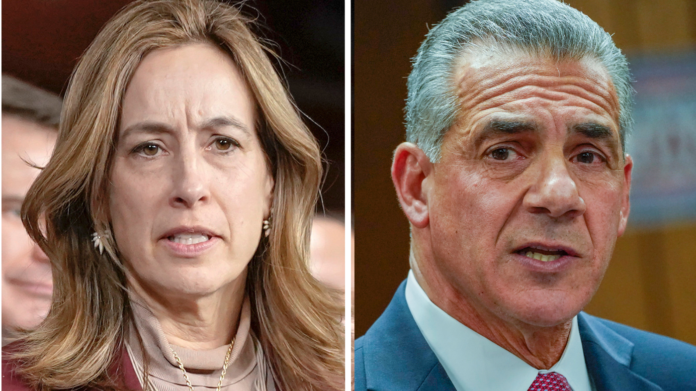With Election Day only weeks away, the fight for New Jersey’s governorship has become one of the closest and most consequential contests in recent memory.
Democratic Congresswoman Mikie Sherrill and Republican Jack Ciattarelli are running neck-and-neck, trading barbs in forums, clashing on taxes and infrastructure, and vying to capture an electorate weary of economic uncertainty and political division.
Polls suggest the race could go down to the wire. Stockton University’s latest survey found the two candidates tied, while Emerson’s poll echoed that deadlock and Fox News gave Sherrill a modest lead. For political observers, this has quickly become a battle not just over who will occupy the governor’s office in Trenton, but over the broader future direction of New Jersey itself.
What’s Driving the Race: Taxes, Economy, and Infrastructure
If there’s one issue that consistently dominates New Jersey campaigns, it’s taxes. The Stockton poll confirmed what every candidate for state office knows: property taxes are the perennial concern for voters across the Garden State. Residents are deeply frustrated by what they see as an endless upward climb in costs, coupled with a sense that government often fails to deliver value for their money.
Sherrill has pledged not to raise the state sales tax, clarifying a past statement that left room for speculation. Instead, she has stressed shared services among municipalities to reduce redundancies and cut costs. Ciattarelli, meanwhile, has promised to resist any push for higher taxes while continuing to defend local home rule. He argues that New Jerseyans value their town identities and independence, even if consolidation could potentially reduce costs.
Beyond taxes, the federal government shutdown has injected new urgency into the campaign. Sherrill has condemned the Trump administration’s decision to withhold funding for the Hudson River Tunnel Project, an infrastructure initiative critical to the region’s economic vitality. Ciattarelli has countered by accusing Sherrill and her Democratic colleagues of mismanaging their role in Washington and contributing to dysfunction.
The tunnel fight has resonance well beyond commuters. It symbolizes the stakes of federal-state cooperation, and for many voters it embodies the frustration of seeing vital projects delayed by political brinkmanship.
Candidate Profiles: Two Very Different Paths
Mikie Sherrill, a former Navy helicopter pilot and federal prosecutor, entered politics in 2018 when she flipped New Jersey’s 11th Congressional District. Known for her disciplined campaign style and focus on national security, she has carved out a reputation as a pragmatic Democrat willing to reach across the aisle on some issues while standing firmly progressive on others. Sherrill’s military background has been both a strength and a point of controversy during the campaign. The release of her Naval Academy records sparked heated debate, particularly around her decision not to attend graduation ceremonies in 1994. She has described the choice as an act of principle; Ciattarelli has painted it as evidence of deeper problems.
Jack Ciattarelli is no stranger to statewide politics. A former state assemblyman and businessman, he was the Republican nominee for governor in 2021, losing narrowly to incumbent Phil Murphy. Since then, he has built his campaign on a message of fiscal responsibility, local control, and opposition to what he frames as overreach by Democratic leadership. Ciattarelli has portrayed Sherrill as a continuation of Murphy’s policies, insisting that electing her would mean “four more years of the same.”
The Regional Divide: North vs. South
New Jersey politics is often defined by geography as much as ideology. North Jersey, with its proximity to New York City, diverse communities, and commuter-heavy suburbs, tends to lean Democratic. South Jersey, culturally and politically distinct, has historically been more competitive, with stronger Republican roots in counties like Gloucester, Cape May, and Salem. Central Jersey — whose existence is still debated by locals — often functions as a battleground region.
Sherrill’s strength is expected to come from suburban North Jersey, where voters have shifted away from Republicans in recent years, especially among college-educated women and younger professionals. Ciattarelli’s path depends heavily on energizing turnout in South Jersey, as well as cutting into Democratic margins in swing counties like Middlesex and Monmouth.
The Gloucester County ballot controversy has further heightened attention on South Jersey. After a judge ruled that illegally designed ballots will remain in circulation, political tensions have escalated, with impeachment proceedings looming against the county clerk and a state attorney general investigation underway. The issue has stirred concerns about election integrity at a moment when voter trust is already fragile.
Polls and the Volatile Electorate
The polling landscape underscores just how unsettled this race remains. Stockton and Emerson polls show a dead heat, but Fox’s survey placed Sherrill ahead by eight points, illustrating the difficulty of predicting outcomes in a state as diverse as New Jersey.
Demographics tell part of the story. Older voters, particularly those outside of major metropolitan areas, have leaned toward Ciattarelli. Younger and more diverse populations, concentrated in urban centers like Newark, Jersey City, and Paterson, remain strongly Democratic but are less consistent in voter turnout during off-year elections. That dynamic gives both campaigns reason for urgency.
Sherrill has invested heavily in mobilization efforts aimed at young and suburban voters, while Ciattarelli has worked to energize small business owners and long-time residents frustrated with rising costs and state bureaucracy.
The National Context
While this is a state election, national politics are impossible to ignore. The federal government shutdown and disputes over the Hudson River Tunnel project tie directly into Washington debates. Immigration has also surfaced after the Trump administration revealed plans to expand detention facilities at Joint Base McGuire-Dix-Lakehurst, though details remain scarce.
For Democrats, New Jersey is also a test case for whether suburban trends that began during the Trump presidency can be sustained. For Republicans, a Ciattarelli victory would represent a major breakthrough in a blue-leaning state and could set the tone for national races in 2026.
Other Headlines Shaping the Political Climate
Even beyond the governor’s race, New Jersey politics has been active on multiple fronts:
- Governor Phil Murphy announced a $130 million allocation of opioid settlement funds, aiming to expand harm reduction services and provide resources for families affected by addiction.
- The New Jersey Housing and Mortgage Finance Agency unveiled a program to fund affordable and workforce housing development, tackling one of the state’s most persistent issues.
- A $2.5 billion redevelopment project in Middlesex County has broken ground, anchored by the construction of a massive Bass Pro Shops store.
These developments reflect the breadth of policy challenges facing the next governor, from public health and housing affordability to economic development and infrastructure.
The Battle Over Tone and Civility
Beyond policy, the tone of this race has raised questions about the state of political discourse. The “College Civility Tour” has even made New Jersey a stop, promoting the idea that politics doesn’t have to be toxic. Yet the exchanges between Sherrill and Ciattarelli — particularly over Naval Academy records and campaign trail accusations — suggest civility is in short supply.
Still, many voters crave exactly that: leaders who can govern without constant acrimony. Whether either candidate can convince the electorate they embody that ideal remains an open question.
Looking Back: Historical Context of New Jersey Governor’s Races
New Jersey has a long tradition of competitive gubernatorial elections. Though Democrats have dominated presidential contests in the state, the governor’s mansion has frequently flipped between parties. Tom Kean’s landslide wins in the 1980s, Christine Todd Whitman’s two terms in the 1990s, and Chris Christie’s rise in the 2010s all reflect a willingness among New Jerseyans to split their votes.
Phil Murphy’s re-election in 2021 was far narrower than expected, showing that even in a state often labeled “deep blue,” Republicans remain competitive. Ciattarelli’s strong showing in that race has helped fuel GOP optimism that 2025 could finally be their year.
What’s Next
The only certainty heading into the final month is uncertainty itself. With polls fluctuating, controversies flaring, and both campaigns ramping up advertising and ground operations, the 2025 governor’s race could be decided by razor-thin margins.
For voters, the choice will come down to whether they see Sherrill as a fresh but pragmatic leader ready to build on Murphy’s legacy, or Ciattarelli as a needed course correction for a state long burdened by high taxes and bureaucracy.
New Jersey’s reputation for competitive and colorful politics is once again on display. And as the clock ticks toward Election Day, the Garden State is set to deliver a contest that will be studied and debated well beyond its borders.
To stay updated on this race and other key political stories across the state, Explore New Jersey offers continuing coverage here.











